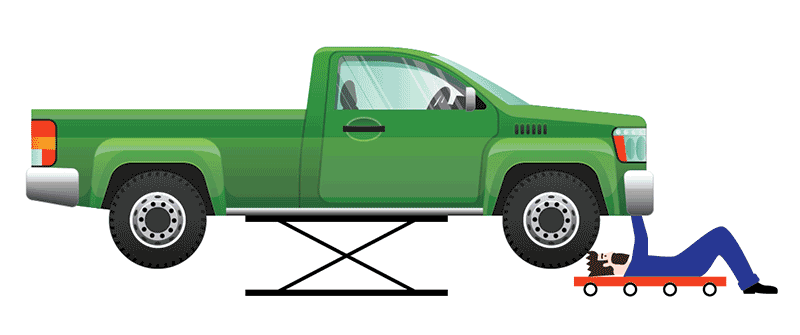The best car lift for a small workshop is a commercial grade 2-post or 4-post lift, which is why they’re used in just about every vehicle repair shop in the world.
In fact, most of the time, home garages lifts do NOT fit in a vehicle repair shop. A commercial lift needs 11-foot ceilings and extra-wide garage space (in terms of width).
So, the question is not “What’s the best car lift for a vehicle repair shop?,” but rather “What’s the best lift that will fit in my workshop?”
The Best Vehicle Repair Shop Car Lift Is Safe, Straightforward, and Works With Almost Any Kind of Car
If you want the best car lift for your repair shop, there are four features you absolutely need:
Safety. A lift that can fail during raising or lowering is dangerous. A lift that doesn’t properly secure a vehicle is life-threatening. Many of the lifts on the market today have problems with tipping front-to-back (because they lift a car between the wheels) as well as failures during raise and lower (because they use independent hydraulic mechanisms).

When you don’t lift a vehicle at the wheels, you have problems with tipping front to back…especially if the work you’re doing involves a heavy component like a differential or engine block.
Simple, straightforward design. When you have time to work on your vehicle, the last thing you want to be doing is inspecting your lift, replacing fluid and looking for leaks, checking air cylinder pressures or doing leak clean-up.
Unfortunately, most of the entry-level hydraulic lifts on the market have precisely these problems. This is because cheap hydraulics are infamous for random, unexplained fluid leaks and problems…and you can’t buy a cheap hydraulic car lift without getting cheap hydraulics!
Nearly universal vehicle compatibility. If you’re serious enough to invest in a vehicle lift, odds are you need a lift that works with nearly any type of vehicle. Who needs a lift with an absurdly low 3,500lbs weight limit? Or a lift that only works if a vehicle has 5″ of ground clearance? Or a lift that isn’t compatible with classic cars that don’t have unibody frames?
True portability, or park on top convenience. If your workshop looks like most other shops, there’s not a lot of ‘extra’ space for your lift. So, you need a lift that you can other disassemble and stow away, or you need a lift you can easily park on top of.
As you might have guessed, the Unite Auto Lift is all of these things. You can learn more about why you should buy the Unite Auto Lift here.
The Worst Vehicle Repair Shop Car Lifts Have a Few Things In Common
There’s such a thing as an “entry-level hydraulic lift,” and the companies that sell them promise all the same functionality as a commercial lift, only in a smaller package. These lifts are always available at a bargain price too (amazing, huh?).
Most of the companies hawking entry-level hydraulic lifts say and do a few of the same things:
They emphasize “Look at it go up and down!” in marketing – Most of the companies selling entry-level hydraulic lifts put a lot of emphasis on the “gee whiz” aspect of their product. “Push a button and up it goes! Neato!” Indeed, the entire homepage of the website is dedicated to a video showing a lift go up and down.
Here’s the problem: Going up and down is maybe 2% of what a vehicle lift is supposed to do. 98% of the time, the lift has to be a safe and stable platform for you to work under. It shouldn’t wobble or seem unsteady at full rise height. It shouldn’t tip back and forth when you pull the rear axle or swap out your engine.
Misleading ground clearance specs. If you’ve got a vehicle with about 4″ of ground clearance (a Miata, a Corvette, a Porsche, most lowered vehicles, and so on), you need to make sure that the lift you’re looking at can actually lift your car. While most of the companies selling these lifts advertise that their lift mechanisms are 3.5″ tall (or thereabouts), and therefore state that the lift will slide ‘under’ a car with 4″ of ground clearance, here’s the reality:
- Most hydraulic motors in the ‘entry-level’ price bracket are just barely powerful enough to do the job
- When you fully compress the lift mechanism, the motor struggles to lift anything heavy
Check the owner’s manual or FAQ page for of any of these entry-level hydraulic units, and you’ll see some text about the lift needing “a little bit of space” or “run-up” before it can actually lift something. That’s fine if you’re trying to lift a vehicle with 5″ of ground clearance. But a Corvette or a Porsche? You might be driving up onto small blocks to get your entry-level lift to do its job.
